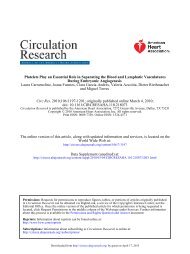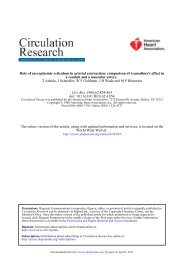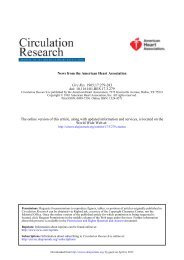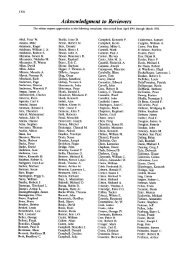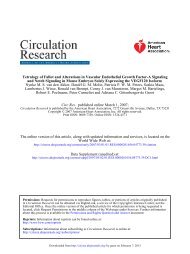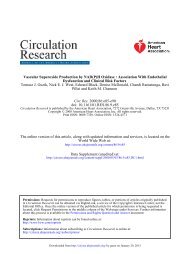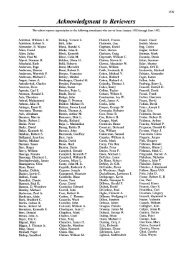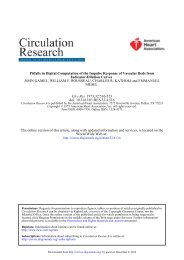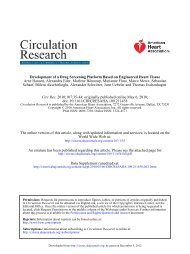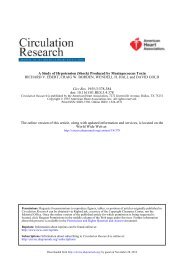CD40-CD40L and Platelet Function - Circulation Research
CD40-CD40L and Platelet Function - Circulation Research
CD40-CD40L and Platelet Function - Circulation Research
You also want an ePaper? Increase the reach of your titles
YUMPU automatically turns print PDFs into web optimized ePapers that Google loves.
<strong>CD40</strong>-<strong>CD40</strong>L <strong>and</strong> <strong>Platelet</strong> <strong>Function</strong> : Beyond Hemostasis<br />
Jane E. Freedman<br />
Circ Res. 2003;92:944-946<br />
doi: 10.1161/01.RES.0000074030.98009.FF<br />
<strong>Circulation</strong> <strong>Research</strong> is published by the American Heart Association, 7272 Greenville Avenue, Dallas, TX 75231<br />
Copyright © 2003 American Heart Association, Inc. All rights reserved.<br />
Print ISSN: 0009-7330. Online ISSN: 1524-4571<br />
The online version of this article, along with updated information <strong>and</strong> services, is located on the<br />
World Wide Web at:<br />
http://circres.ahajournals.org/content/92/9/944<br />
Permissions: Requests for permissions to reproduce figures, tables, or portions of articles originally published<br />
in <strong>Circulation</strong> <strong>Research</strong> can be obtained via RightsLink, a service of the Copyright Clearance Center, not the<br />
Editorial Office. Once the online version of the published article for which permission is being requested is<br />
located, click Request Permissions in the middle column of the Web page under Services. Further information<br />
about this process is available in the Permissions <strong>and</strong> Rights Question <strong>and</strong> Answer document.<br />
Reprints: Information about reprints can be found online at:<br />
http://www.lww.com/reprints<br />
Subscriptions: Information about subscribing to <strong>Circulation</strong> <strong>Research</strong> is online at:<br />
http://circres.ahajournals.org//subscriptions/<br />
Downloaded from<br />
http://circres.ahajournals.org/ by guest on July 3, 2013
<strong>CD40</strong>-<strong>CD40</strong>L <strong>and</strong> <strong>Platelet</strong> <strong>Function</strong><br />
Beyond Hemostasis<br />
Traditionally, platelets have been thought of as<br />
anuclear, subcellular fragments derived from<br />
megakaryocytes circulating in blood as small discs<br />
<strong>and</strong> mitigating hemorrhage. This hemostatic process requires<br />
platelet activation, a complex chain of events involving rapid<br />
structural changes that activate adhesion receptors, remodel<br />
the cytoskeleton, <strong>and</strong> lead to the eventual synthesis <strong>and</strong><br />
secretion of various platelet-derived factors. The result of this<br />
cascade is the formation of platelet-dependent thrombosis<br />
that primarily attenuates bleeding but, in pathophysiological<br />
settings, contributes to occlusive vascular events. These<br />
clinical realities have led to the bias that platelets are<br />
primarily involved in thrombosis <strong>and</strong> hemostasis. This bias<br />
has been reflected in the predominant use of platelet aggregometry<br />
as the st<strong>and</strong>ard method for quantifying platelet<br />
activation ex vivo. This technique, however, only identifies<br />
platelet-platelet binding (homotypic aggregates) <strong>and</strong>, in clinical<br />
settings, has promoted a relatively simplistic vision of<br />
platelet function. The focus on platelet-dependent thrombosis<br />
has made the platelet aggregate a common therapeutic target<br />
in syndromes involving vascular occlusion. However, merely<br />
preventing the process of platelet-platelet binding may not<br />
always translate into clinical efficacy as seen in the recent<br />
disappointing results associated with the use of the oral<br />
IIb/IIIa inhibitors. 1<br />
Recently, studies have suggested that platelets also participate<br />
in inflammatory reactions. <strong>Platelet</strong>s are known to<br />
produce inflammatory mediators including platelet-derived<br />
growth factor, platelet factor 4, <strong>and</strong> transforming growth<br />
factor-. <strong>Platelet</strong>s are also known to bind, via P-selectin<br />
(CD62P) expressed on the surface of activated platelets to the<br />
leukocyte receptor, P-selectin glycoprotein lig<strong>and</strong>-1 (PSGL-<br />
1). The relevance of this binding is supported by a study<br />
demonstrating that the infusion of recombinant soluble human<br />
form of P-selectin glycoprotein lig<strong>and</strong>-1 in an animal<br />
model of vascular injury reduced myocardial reperfusion<br />
injury <strong>and</strong> preserved vascular endothelial function. 2 The<br />
clinical implications of heterotypic aggregates are shown by<br />
studies demonstrating that after acute myocardial infarction,<br />
circulating monocyte-platelet aggregates are both increased<br />
The opinions expressed in this editorial are not necessarily those of the<br />
editors or of the American Heart Association.<br />
From the Whitaker Cardiovascular Institute <strong>and</strong> Evans Department of<br />
Medicine, Boston University School of Medicine, Boston, Mass.<br />
Correspondence to Jane E. Freedman, MD, Boston University School<br />
of Medicine, 715 Albany St, W507, Boston, MA 02118. E-mail<br />
freedmaj@bu.edu<br />
(Circ Res. 2003;92:944-946.)<br />
© 2003 American Heart Association, Inc.<br />
<strong>Circulation</strong> <strong>Research</strong> is available at http://www.circresaha.org<br />
DOI: 10.1161/01.RES.0000074030.98009.FF<br />
See related article, pages 1041–1048<br />
Jane E. Freedman<br />
<strong>and</strong> are a more sensitive marker of in vivo platelet activation<br />
than platelet surface P-selectin. 3 Plaque rupture promotes<br />
activation of the inflammatory responses, <strong>and</strong> the consistent<br />
finding of heterotypic aggregates highlights the close interaction<br />
between inflammation <strong>and</strong> thrombosis in vascular<br />
disease.<br />
Contributing to our underst<strong>and</strong>ing of the role of platelets in<br />
inflammation are <strong>CD40</strong>-<strong>CD40</strong> lig<strong>and</strong> (<strong>CD40</strong>L) interactions.<br />
<strong>CD40</strong> is a membrane glycoprotein belonging to the tumor<br />
necrosis family receptor superfamily <strong>and</strong> its lig<strong>and</strong> <strong>CD40</strong>L<br />
(CD154) is a glycoprotein from the tumor necrosis factor<br />
family. <strong>CD40</strong>-<strong>CD40</strong>L interactions are central in immune<br />
responses <strong>and</strong> inflammation. Ligation of <strong>CD40</strong> on various<br />
vascular cells contributes to the pathogenesis of atherosclerotic,<br />
thrombotic, <strong>and</strong> inflammatory processes. 4,5 On endothelial<br />
cells or monocytes, the engagement of <strong>CD40</strong> leads to<br />
the synthesis of adhesion molecules, chemokines, <strong>and</strong> tissue<br />
factor <strong>and</strong> causes the activation of matrix metalloproteinases.<br />
<strong>CD40</strong>L has also been detected in platelets 4 where, after<br />
stimulation, it is translocated to the platelet surface (Figure).<br />
The surface-expressed <strong>CD40</strong> lig<strong>and</strong> is then cleaved from the<br />
platelet over a period of minutes to hours subsequently<br />
generating a soluble fragment (soluble <strong>CD40</strong> lig<strong>and</strong> or<br />
s<strong>CD40</strong>L). 6 It is estimated that 95% of the circulating<br />
s<strong>CD40</strong>L is derived from platelets. 6 Found to be increased on<br />
platelets in fresh thrombus, 4 s<strong>CD40</strong>L has been shown to be<br />
elevated in cardiovascular disease 7,8 <strong>and</strong> associated with<br />
increased cardiovascular risk in apparently healthy women. 9<br />
Although s<strong>CD40</strong>L has been characterized as a marker of<br />
thrombotic diseases, much less is known about its direct role<br />
in platelet function. It has been suggested that <strong>CD40</strong>L is an<br />
IIb 3 lig<strong>and</strong>, a platelet agonist, <strong>and</strong> contributes to stability of<br />
arterial thrombi. 6 In this issue of <strong>Circulation</strong> <strong>Research</strong>,<br />
Inwald <strong>and</strong> colleagues 10 add to the limited information<br />
concerning the effects of s<strong>CD40</strong>L on platelet function <strong>and</strong><br />
demonstrate that <strong>CD40</strong> ligation may be a mechanism for<br />
platelet activation. After incubation of platelets with the<br />
trimeric form of s<strong>CD40</strong>L (s<strong>CD40</strong>LT), they showed enhanced<br />
CD62P expression as well as dense <strong>and</strong> -granule release.<br />
Interestingly, the presence of a glycoprotein IIb/IIIa blocking<br />
agent did not alter s<strong>CD40</strong>LT-induced CD62P expression. In<br />
addition, -thromboglobulin <strong>and</strong> [ 14 C]-5-HT were shown to<br />
be present after ligation reflecting - <strong>and</strong> dense granule<br />
release, respectively. An intriguing part of this study is the<br />
confirmatory data using subjects with X-linked hyper-IgM<br />
syndrome <strong>and</strong> known absence of <strong>CD40</strong>L expression. The<br />
ability to utilize these subjects is particularly interesting in<br />
platelet-dependent studies as genetic manipulation in cell<br />
culture is not possible.<br />
Downloaded from<br />
http://circres.ahajournals.org/<br />
944 by guest on July 3, 2013
At issue is the form <strong>and</strong> concentration of s<strong>CD40</strong>L used in<br />
the studies. In the experiments, the concentration of<br />
s<strong>CD40</strong>LT used was 1 g/mL although platelet activation was<br />
present at concentrations as low as 100 ng/mL. Although<br />
these concentrations are similar to those reported in the<br />
literature for <strong>CD40</strong>L activation of other cell types, it is still<br />
greater than the levels reported in patients (50 ng/mL).<br />
Although this discrepancy may question the clinical relevance<br />
of the findings of Inwald et al, 10 it is possible that local<br />
concentrations in active areas of thrombotic or inflammatory<br />
disease are higher. This would allow a dose-dependent<br />
mechanism for targeting the effects of s<strong>CD40</strong>L. Further<br />
kinetic studies <strong>and</strong> assessment of in vivo concentrations are<br />
needed to answer the question of relevance in relation to the<br />
levels used in these studies. In addition, the trimeric form of<br />
s<strong>CD40</strong>L was used in the studies <strong>and</strong> it has been shown that<br />
the specific activity of s<strong>CD40</strong>L may depend on its form as a<br />
trimer or monomer. Although the membrane-bound <strong>CD40</strong>L<br />
may be trimeric, 11 there is debate concerning the soluble<br />
form. 4,11 Further studies, specifically in platelets, would be<br />
required to clarify this question.<br />
In the studies by Inwald et al, 10 platelet activation via<br />
s<strong>CD40</strong>LT occurred in the presence of a IIb 3 inhibitor. This<br />
appears to be in contrast to previous work that demonstrates<br />
that s<strong>CD40</strong>L is an IIb3 lig<strong>and</strong>. 6 However, a more intriguing<br />
interpretation is that this is not only a novel means of platelet<br />
activation but that the platelet may be activated in distinct<br />
ways in different settings. In the present study by Inwald et al,<br />
incubation with s<strong>CD40</strong>LT resulted in significantly less<br />
CD62P expression compared with platelet activation with<br />
thrombin receptor agonist peptide 1-6 (SFLLRN). In addition,<br />
the increase in Pac-1 is minimal with s<strong>CD40</strong>L compared<br />
with SFLLRN. Differences in dense granule release were also<br />
detected with thrombin receptor stimulation leading to 5<br />
times [ 14 C]-5-HT levels compared with s<strong>CD40</strong>LT incubation.<br />
Similar results were not shown for -thromboglobulin <strong>and</strong><br />
further analysis of -granules as well as the effects of other<br />
Freedman <strong>CD40</strong>-<strong>CD40</strong>L <strong>and</strong> <strong>Platelet</strong> <strong>Function</strong> 945<br />
After platelet stimulation, <strong>CD40</strong>L is translocated<br />
to the platelet surface. Surfaceexpressed<br />
<strong>CD40</strong> lig<strong>and</strong> is then cleaved<br />
from the platelet over a period of minutes<br />
to hours, subsequently generating a<br />
soluble fragment, s<strong>CD40</strong>L. Soluble<br />
<strong>CD40</strong>L can then promote inflammatory<br />
or thrombotic response by causing further<br />
platelet activation or, in high-shear<br />
settings, may enhance the formation of<br />
homotypic aggregates.<br />
agonists would be of interest. However, it may be possible<br />
that in areas of relevant concentrations, the presence of<br />
s<strong>CD40</strong>L leads to selective activation <strong>and</strong> granule release but<br />
excludes the formation of homotypic aggregates. This possibility<br />
is strengthened by the finding that s<strong>CD40</strong>LT enhanced<br />
platelet-neutrophil formation occurs in the setting of minimal<br />
IIb 3 activation <strong>and</strong> that platelets from subjects deficient in<br />
<strong>CD40</strong>L aggregated normally. However, in the setting of high<br />
shear, IIb 3 may be engaged leading to thrombus formation.<br />
Thus, these differences could allow for a partial separation of<br />
the thrombotic <strong>and</strong> inflammatory roles of platelets. The<br />
mechanism for the s<strong>CD40</strong>L-induced cascade of platelet<br />
activation is not known. In the present study, the experiments<br />
suggesting that there was no change in calcium flux after<br />
s<strong>CD40</strong>L stimulation are too limited to draw conclusions or to<br />
infer that protein kinase C signaling is responsible. However,<br />
the possibility that ligation of <strong>CD40</strong>, as well as binding to<br />
IIb 3, can lead to outside-in signaling in the absence of<br />
inside-out signaling is intriguing. However, not all means of<br />
inside-out stimulation in platelets are calcium-dependent. To<br />
conclude that <strong>CD40</strong>-<strong>CD40</strong>L interactions are resulting in<br />
outside-in signaling or G protein–independent activation<br />
requires further examination.<br />
Although many questions remain, these findings help to<br />
clarify if s<strong>CD40</strong>L is released to further drive plateletdependent<br />
thrombus formation or inflammatory reactions in<br />
the vasculature. The partial <strong>and</strong> selective activation that<br />
appears after engagement of <strong>CD40</strong> suggests that the platelet<br />
is involved in both functions <strong>and</strong> that it may have the capacity<br />
to be differentially regulated. Continuing to define the role of<br />
platelets in inflammation <strong>and</strong> the extent to which its thrombotic<br />
functions are complementary will be challenging. The<br />
anuclear platelet is being rediscovered as an intriguing link<br />
between thrombosis <strong>and</strong> inflammation, <strong>and</strong> future research<br />
should provide great insight into platelet-dependent mechanisms<br />
leading to the regulation of vascular disease.<br />
Downloaded from<br />
http://circres.ahajournals.org/ by guest on July 3, 2013
946 <strong>Circulation</strong> <strong>Research</strong> May 16, 2003<br />
Acknowledgments<br />
This work was supported in part by NIH grants NIH RO1AG08226<br />
(J.F.), NIH RO1HL62267 (J.F.), <strong>and</strong> an Established Investigator<br />
Award from the American Heart Association.<br />
References<br />
1. Chew DP, Bhatt DL, Sapp S, Topol EJ. Increased mortality with oral<br />
platelet glycoprotein IIb/IIIa antagonists: a meta-analysis of phase III<br />
multicenter r<strong>and</strong>omized trials. <strong>Circulation</strong>. 2001;103:201–206.<br />
2. Hayward R, Campbell B, Shin YK, Scalia R, Lefer AM. Recombinant<br />
soluble P-selectin glycoprotein lig<strong>and</strong>-1 protects against myocardial ischemic<br />
reperfusion injury in cats. Cardiovasc Res. 1999;41:65–76.<br />
3. Michelson AD, Barnard MR, Krueger LA, Valeri CR, Furman MI. Circulating<br />
monocyte-platelet aggregates are a more sensitive marker of in<br />
vivo platelet activation than platelet surface P-selectin: studies in<br />
baboons, human coronary intervention, <strong>and</strong> human acute myocardial<br />
infarction. <strong>Circulation</strong>. 2001;104:1533–1537.<br />
4. Henn V, Slupsky JR, Grafe M, Anagnostopoulos I, Forster R, Muller-<br />
Berghaus G, Kroczek RA. <strong>CD40</strong> lig<strong>and</strong> on activated platelets triggers an<br />
inflammatory reaction of endothelial cells. Nature. 1998;391:591–594.<br />
5. Mach F, Schonbeck U, Sukhova GK, Atkinson E, Libby P. Reduction of<br />
atherosclerosis in mice by inhibition of <strong>CD40</strong> signalling. Nature. 1998;<br />
394:200–203.<br />
6. Andre P, Prasad KS, Denis CV, He M, Papalia JM, Hynes RO, Phillips<br />
DR, Wagner DD. <strong>CD40</strong>L stabilizes arterial thrombi by a 3 integrin–<br />
dependent mechanism. Nat Med. 2002;8:247–252.<br />
7. Freedman JE. <strong>CD40</strong> lig<strong>and</strong>–assessing risk instead of damage? N Engl<br />
J Med. 2003;348:1163–1165.<br />
8. Heeschen C, Dimmeler S, Hamm CW, van den Br<strong>and</strong> MJ, Boersma E,<br />
Zeiher AM, Simoons ML. Soluble <strong>CD40</strong> lig<strong>and</strong> in acute coronary syndromes.<br />
N Engl J Med. 2003;348:1104–1111.<br />
9. Schonbeck U, Varo N, Libby P, Buring J, Ridker PM. Soluble <strong>CD40</strong>L<br />
<strong>and</strong> cardiovascular risk in women. <strong>Circulation</strong>. 2001;104:2266–2268.<br />
10. Inwald DP, McDowall A, Peters MJ, Callard RE, Klein NJ. <strong>CD40</strong> is<br />
constitutively expressed on platelets <strong>and</strong> provides a novel mechanism for<br />
platelet activation. Circ Res. 2003;92:1041–1048.<br />
11. Peitsch MC, Jongeneel CV. A 3-D model for the <strong>CD40</strong> lig<strong>and</strong> predicts<br />
that it is a compact trimer similar to the tumor necrosis factors. Int<br />
Immunol. 1993;5:233–238.<br />
KEY WORDS: platelets <strong>CD40</strong>/<strong>CD40</strong>L thrombosis inflammation<br />
Downloaded from<br />
http://circres.ahajournals.org/ by guest on July 3, 2013




